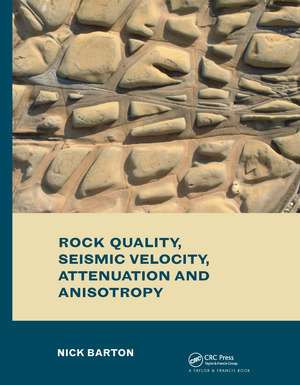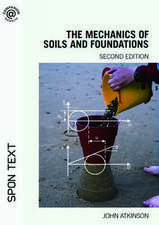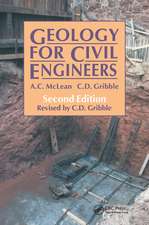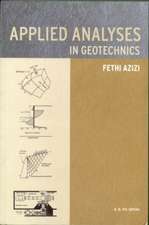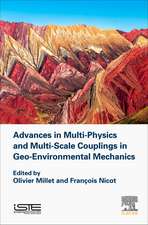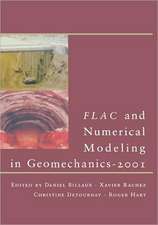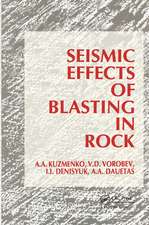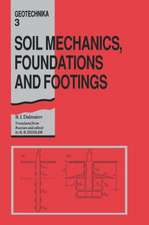Rock Quality, Seismic Velocity, Attenuation and Anisotropy
Autor Nick Bartonen Limba Engleză Hardback – 3 noi 2006
This book describes seismic behaviour at many scales and from numerous fields in geophysics, tectonophysics and rock physics, and from civil, mining and petroleum engineering. Addressing key items for improved understanding of seismic behaviour, it often interprets seismic measurements in rock mechanics terms, with particular attention to the cause of attenuation, its inverse seismic quality, and the anisotropy of fracture compliances and stiffnesses.
Reviewed behaviour stretches over ten orders of magnitude, from micro-crack compliance in laboratory tests to cross-continent attenuation. Between these extremes lie seismic investigation of rock joints, boreholes, block tests, dam and bridge foundations, quarry blasting, canal excavations, hydropower and transportation tunnels, machine bored TBM tunnels, sub-sea sediment and mid-ocean ridge measurements, where the emphasis is on velocity-depth-age models. Attenuation of earthquake coda-waves is also treated, including in-well measurements.
In the later chapters, there is a general emphasis on deeper, higher stress, larger scale applications of seismic, such as shear-wave splitting for interpreting the attenuation, anisotropy and orientation of permeable 'open' fracture sets in petroleum reservoirs, and the 4D seismic effects of water-flood, oil production and compaction. The dispersive or frequency dependence of most seismic measurements and their dependence on fracture dimensions and fracture density is emphasized. The possibility that shear displacement may be required to explain permeability at depth is quantified.
This book is cross-disciplinary, non-mathematical and phenomenological in nature, containing a wealth of figures and a wide review of the literature from many fields in the Earth Sciences. Including a chapter of conclusions and an extensive subject index, it is a unique reference work for professionals, researchers, university teachers and students working in the fields of geophysics, civil, mining and petroleum engineering. It will be particularly relevant to geophysicists, engineering geologists and geologists who are engaged in the interpretation of seismic measurements in rock and petroleum engineering.
Preț: 1437.49 lei
Preț vechi: 1913.49 lei
-25% Nou
Puncte Express: 2156
Preț estimativ în valută:
275.15€ • 298.98$ • 231.28£
275.15€ • 298.98$ • 231.28£
Carte tipărită la comandă
Livrare economică 21 aprilie-05 mai
Preluare comenzi: 021 569.72.76
Specificații
ISBN-13: 9780415394413
ISBN-10: 0415394414
Pagini: 766
Ilustrații: 610 b/w images and 30 tables
Dimensiuni: 219 x 276 x 41 mm
Greutate: 2.29 kg
Ediția:1
Editura: CRC Press
Colecția CRC Press
Locul publicării:Boca Raton, United States
ISBN-10: 0415394414
Pagini: 766
Ilustrații: 610 b/w images and 30 tables
Dimensiuni: 219 x 276 x 41 mm
Greutate: 2.29 kg
Ediția:1
Editura: CRC Press
Colecția CRC Press
Locul publicării:Boca Raton, United States
Public țintă
Postgraduate and ProfessionalCuprins
The Multidisciplinary Scope of Seismic and Rock Quality. Revealing Hidden Rock Conditions. Some Basic Principles of P, S and Q. Q and Q XVII Limitations of Refraction Seismic Bring Tomographic Solutions. Part 1: 1. Shallow Seismic Refraction, some Basic Theory, and the Importance of Rock Type 2. Environmental Effects on Velocity 3. Effects of Anisotropy on Vp 4. Cross-Hole Velocity and Cross-Hole Velocity Tomography 5. Relationships between Rock Quality, Depth and Seismic Velocity 6. Deformation Moduli and Seismic Velocities 7. Excavation Disturbed Zones and their Seismic Properties 8. Seismic Measurements for Tunnelling 9. Relationships between Vp, Lugeon Value, Permeability and Grouting in Jointed Rock Part 2: 10. Seismic Quality Q and Attenuation at Many Scales 11. Velocity Structure of the Earth’s Crust 12. Rock Stress, Pore Pressure, Borehole Stability and Sonic Logging 13. Rock Physics at Laboratory Scale 14. P-Waves for Characterising Fractured Reservoirs 15. Shear Wave Splitting in Fractured Reservoirs and Resulting from Earthquakes 16. Joint Stiffness and Compliance and the Joint Shearing Mechanism 17. Conclusions Appendix A: The Qrock Parameter Ratings
Recenzii
"This important, wide-ranging compendium of rock physics research is intended to bridge the information gap that exists between rock mechanics engineers involved with projects in civil, mining and petroleum engineering and geophysicists working in areas such as petroleum reservoir and earthquake studies. [...] In the study, largely non-mathematical in nature, the author assembles and refers to a large body of literature concerned with experimental and theoretical studies in which both rock mechanics and geophysics at all scales are involved. [...] [A] most important contribution from which both rock mechanics engineers and geophysicists will benefit immensely." Michael King, Imperial College London, UK
"Let me first start my review by congratulating Barton for making such a cross-disciplinary effort in this book . . . Barton presents an excellent example of what could be accomplished with such collaboration by providing readers a wide perspective of the applications from both geophysics and geomechanics . . . I found the book particularly enjoyable to read since I am a strong advocate of the cross-discipline fertilization of geophysics and geomechanics. I would recommend it as a reference book to both geophysicists and even more to rock mechanics specialists because of the unique multidisciplinary coverage and immense references."
– Azra N. Tutuncu, in The Leading Edge, April 2009, Vol. 28 No. 4
"Let me first start my review by congratulating Barton for making such a cross-disciplinary effort in this book . . . Barton presents an excellent example of what could be accomplished with such collaboration by providing readers a wide perspective of the applications from both geophysics and geomechanics . . . I found the book particularly enjoyable to read since I am a strong advocate of the cross-discipline fertilization of geophysics and geomechanics. I would recommend it as a reference book to both geophysicists and even more to rock mechanics specialists because of the unique multidisciplinary coverage and immense references."
– Azra N. Tutuncu, in The Leading Edge, April 2009, Vol. 28 No. 4
Descriere
This cross-disciplinary work offers an exceptionally relevant examination of those aspects of earth science dealing with seismic behavior of fractured media. It delivers a lucid exploration of rock mechanics, examining the strengths and weakness of structures beneath the earth’s immediate surface. Deliberately non-mathematical and phenomenological in nature, this volume reviews examples of seismic measurements from various fields under widely varied conditions, supported by a wealth of figures drawn from a broad review of the literature. The last chapters delve into deeper, higher stress, and large scale applications, specifically fractured petroleum reservoirs, and earthquake source zone interpretation.
